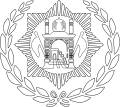Emblem of Afghanistan
| Emblem of the Islamic Emirate of Afghanistan | |
|---|---|
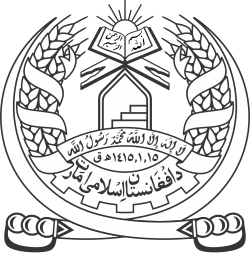 | |
| Versions | |
 Colourized version | |
| Armiger | Islamic Emirate of Afghanistan[a] |
| Adopted | 2021[1] |
| Blazon | A mihrab with a minbar within, supporting the Quran, and crowned by the sun |
| Supporters | Two swords, two sheaves of wheat and a cogwheel |
| Motto | Arabic and Pashto: لا إله إلا الله محمد رسول الله - ١٤١٥,١,١٥هـ ت - د افغانستان اسلامي امارت "There is no god but Allah. Muhammad is the messenger of Allah - 15-1-1415A.H.Q[b] - Islamic Emirate of Afghanistan" |
The National Emblem of Afghanistan is an official symbol of Afghanistan.
The 2013 incarnation of the emblem used by the internationally recognized government of Afghanistan has the inscription of the shahada in Arabic at the top. Below it is the image of a mosque with a mihrab and minbar, or pulpit, within.[2] Attached to the mosque are two flags, taken to stand for flags of Afghanistan. Beneath the mosque is an inscription that states the name of the nation. Around the mosque are sheaves of wheat, and underneath that, the Solar Hijri year 1298 (1919 in the Gregorian calendar), the year Afghanistan gained independence from the British influence.
Following the fall of Kabul to Taliban forces on 15 August 2021, the current status of the emblem is under dispute as the country is disputed between the de facto Islamic Emirate of Afghanistan and the de jure Islamic Republic of Afghanistan.
Historical emblems[]

Emirate of Afghanistan (1901–1919)

Emirate of Afghanistan (1919–1926)

Kingdom of Afghanistan (1926–1928)
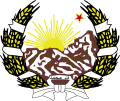
Kingdom of Afghanistan (1928–1929)

Kingdom of Afghanistan (1931–1973)
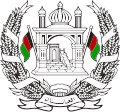
Republic of Afghanistan (1973–1974)
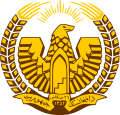
Republic of Afghanistan (1974–1978)
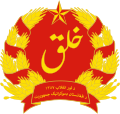
Democratic Republic of Afghanistan (1978–1980)
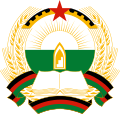
Democratic Republic of Afghanistan (1980–1987)

Republic of Afghanistan (1987–1992)

Islamic State of Afghanistan (1992–2002)

Islamic Emirate of Afghanistan (1996–2001)
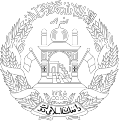
Transitional Islamic State of Afghanistan (2002–2004)
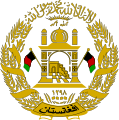
Islamic Republic of Afghanistan (2004–2013)

Islamic Republic of Afghanistan (2013–2021)

Variant of the Islamic Republic of Afghanistan (2013–2021)

Islamic Emirate of Afghanistan (2021–present)

Variant of the Islamic Emirate of Afghanistan (2021–present)
See also[]
Notes[]
- ^ De facto government
- ^ See Islamic calendar
References[]
- ^ "Flag and emblem in Kabul".
- ^ Constitution of Afghanistan, Article 19 http://www.afghanembassy.com.pl/afg/images/pliki/TheConstitution.pdf
External links[]
- National symbols of Afghanistan
- Kingdom of Afghanistan
- National emblems
- Coats of arms with wheat
- Coats of arms with buildings
- Coats of arms with flags
- Afghanistan government stubs
- Heraldry stubs




